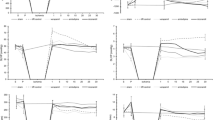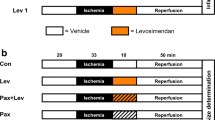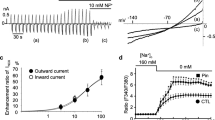Abstract.
It has been argued that activation of KATP channels in the sarcolemmal membrane of heart muscle cells during ischemia provides an endogenous cardioprotective mechanism. In order to test whether the novel cardioselective KATP channel blocker HMR 1098 affects cardiac function during ischemia, experiments were performed in rat hearts during ischemia and reperfusion.
Isolated perfused working rat hearts were subjected to 30 min of low-flow ischemia in which the coronary flow was reduced to 10% of its control value, followed by 30-min reperfusion. In the first set of experiments the hearts were electrically paced at 5 Hz throughout the entire protocol. At the end of the 30-min ischemic period the aortic flow had fallen to 44±2% (n=8) of its nonischemic value in vehicle-treated hearts, whereas in the presence of 0.3 µmol/l and 3 µmol/l HMR 1098 it had fallen to 29±7% (n=5, not significant) and 8±2% (n=12, P<0.05), respectively. Glibenclamide (3 µmol/l) reduced the aortic flow to 9.5±7% (n=4, P<0.05). In control hearts the QT interval in the electrocardiogram shortened from 63±6 ms to 36±4 ms (n=10, P<0.05) within 4–6 min of low-flow ischemia. This shortening was completely prevented by 3 µmol/l HMR 1098 (60±5 ms before ischemia, 67±6 ms during ischemia, n=9, not significant). When rat hearts were not paced, the heart rate fell spontaneously during ischemia, and HMR 1098 (3 µmol/l) caused only a slight, statistically non-significant reduction in aortic flow during the ischemic period.
In order to investigate whether HMR 1098 shows cardiodepressant effects in a more pathophysiological model, the left descending coronary artery was occluded for 30 min followed by reperfusion for 60 min in anesthetized rats. Treatment with HMR 1098 (10 mg/kg i.v.) had no statistically significant effects on mean arterial blood pressure and heart rate during the control, ischemia and reperfusion periods. At the end of the reperfusion period, aortic blood flow was slightly reduced by HMR 1098, without reaching statistical significance (two-way analysis of ANOVA, P=0.15). Myocardial infarct size as a percentage of area at risk was not affected by HMR 1098 (vehicle: 75±3%, HMR 1098: 72±2%, n=7 in each group).
In conclusion, cardiodepressant effects of HMR 1098 were observed only in isolated perfused working rat hearts which were continuously paced during global low-flow ischemia. In the model of anesthetized rats subjected to regional ischemia, HMR 1098 had no significant effect on cardiac function or infarct size.
Similar content being viewed by others
Author information
Authors and Affiliations
Additional information
Electronic Publication
Rights and permissions
About this article
Cite this article
Gögelein, H., Ruetten, H., Albus, U. et al. Effects of the cardioselective KATP channel blocker HMR 1098 on cardiac function in isolated perfused working rat hearts and in anesthetized rats during ischemia and reperfusion. Naunyn-Schmied Arch Pharmacol 364, 33–41 (2001). https://doi.org/10.1007/s002100000391
Received:
Accepted:
Issue Date:
DOI: https://doi.org/10.1007/s002100000391




